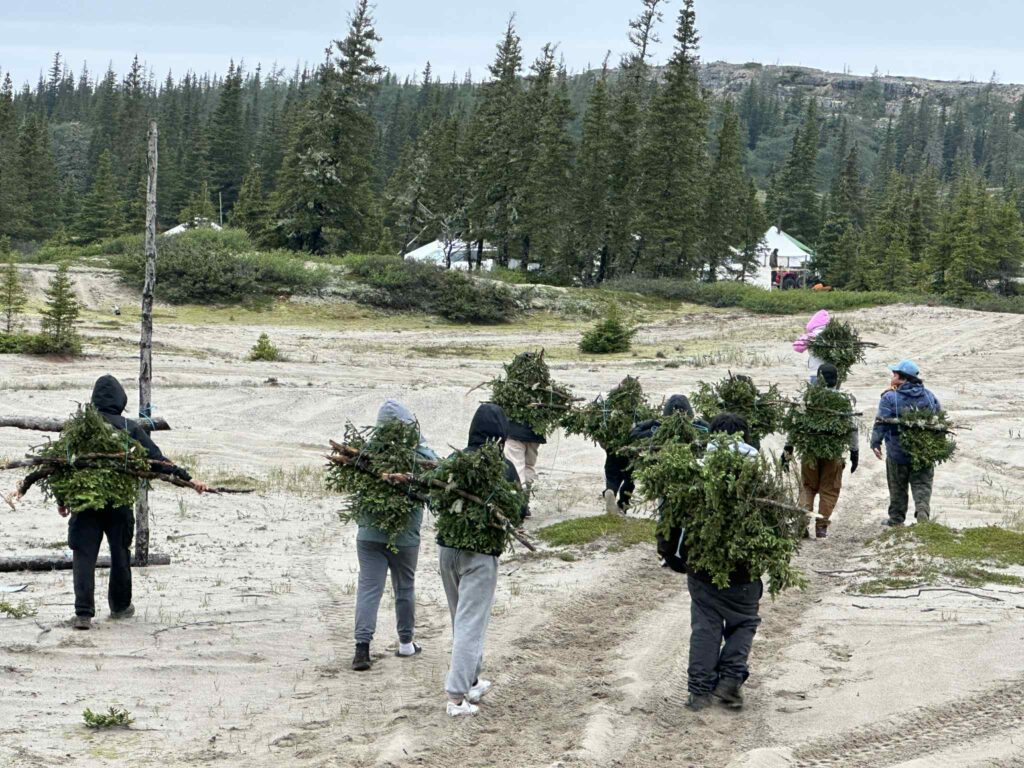Whapmagoostui’s traditional summer gathering at Kilometre 9 was bigger than ever this year, featuring workshops, games and healing activities from June 27 to July 8. A new youth cultural camp was a welcome addition, inspired by the late John Masty, who passed away in May.
“We had a picnic and kids there kept talking to him in English,” recalled camp organizer Davina Cooper. “He saw a huge decline in our traditions, language and culture. He opened my eyes – the whole point was to spark an interest in our youth so they want to learn.”
She has fond childhood memories of speaking Cree with friends while hunting in the bush, but Cooper said that even her own daughter doesn’t speak the language fluently. Organizers aimed to create a safe environment for kids aged 6 to 14 to reinforce Cree language and culture.
“I’m just giving them a starting pack and they can take off with it,” Cooper suggested. “I’ve seen a lot of them flourish – they’ve spoken more in their language, learned how to start a fire, build a teepee, which boughs are for which, and cook traditional food.”
Tina George-Kawapit and Simon Kawapit were instrumental in assembling the program, organizing traditional activities like preparing beaver. Elders Robbie Dick and his wife Elizabeth, who helped launch the annual gathering in 1993, also played key roles.
The first summer gatherings were held at the mouth of the Great Whale River during the community’s struggle to keep its waters flowing free from hydroelectric development. More recently, the gathering has generally been held at KM 9.
As Cooper’s work with the justice department includes running school prevention programs like SNAP (Stop Now and Plan), she knew that a cultural camp would be a perfect fit. Activities were based at a cabin built by the local youth council, which also contributed funding and support.
With interest in the camp far exceeding availability, the 45 participants were divided into two age groups and several others placed on a waiting list. Since many didn’t understand Cree, the majority of activities were language games like scavenger hunts and I Spy.
“One of the rules for the campers was they had to talk in Cree or we acted like we didn’t hear them,” explained Cooper. “They asked me how to ask a question from their teachers. We also did the basic vocabulary with Cree in guessing games – since a lot are competitive, they try to learn more.”
A highlight was learning the cultural significance of how to build a teepee, such as having the door face the east where the sun rises. Children were empowered by building a teepee themselves with a little guidance from instructors.

“It was emotional to see these little ones carrying boughs on their back the traditional way,” shared Amy Salt, the mother of one camper. “My nine-year-old said Simon had so much patience: ‘He’s a good teacher because he told us why we need to do things.’ It shows us how we need to be teaching our children.”
The community has increasingly collaborated with other entities to share the workload and costs of the gathering. The Nishiiyuu Council of Elders, the justice department, Multi-Service Day Centre and others helped provide a range of attractions.
The Whapmagoostui Men’s Group organized a target shooting competition, introducing a category for ages 12 to 15. Prizes were also up for grabs in a fishing derby, nature hunt, obstacle course and a dance competition.
With daily dress-up themes and contests, participants were awarded tickets to win the grand prize of a kraken canoe and outboard motor donated by the Northern Store. Nellie George was the big winner.
Innu rock band Ninan got people dancing July 4, while another evening featured a round dance with drummers. Local musician Eric Sheshamush and his group of young fiddlers gave a rousing performance for a dance competition.
“Some just started a few months ago,” said Salt. “We were emotional when these youth were up there performing for their own community. I think a lot of healing went on this year. Healing is different for everyone, whether it’s dancing, singing, sewing or just talking with others.”
There was a traditional medicine workshop, whose leaders stayed on site to support attendees. Self-care services were also available with reiki and reflexology. Ruth Masty led several workshops making quilts, wood stoves and mosquito hats. Following a difficult spring for the community, Elizabeth Dick organized a grieving workshop.
Many Elders camped until the gathering’s end, enjoying traditional food in the shaptuan and quiet moments in the evening. After excessive evening traffic at last year’s event, night watchmen patrolled a gate at KM 6 to ensure people could relax and sleep well. Several visitors from other communities reconnected with family.
Salt said other communities have contacted them about implementing their land-based healing approach for their own summer gatherings. In her closing remarks, she asked attendees how they could bring the gathering’s spirit into the community all year long.
“How do we bring that energy to make our community feel that way again? It’s working together that brings the community together. It means more when everyone works for the same goal.”





